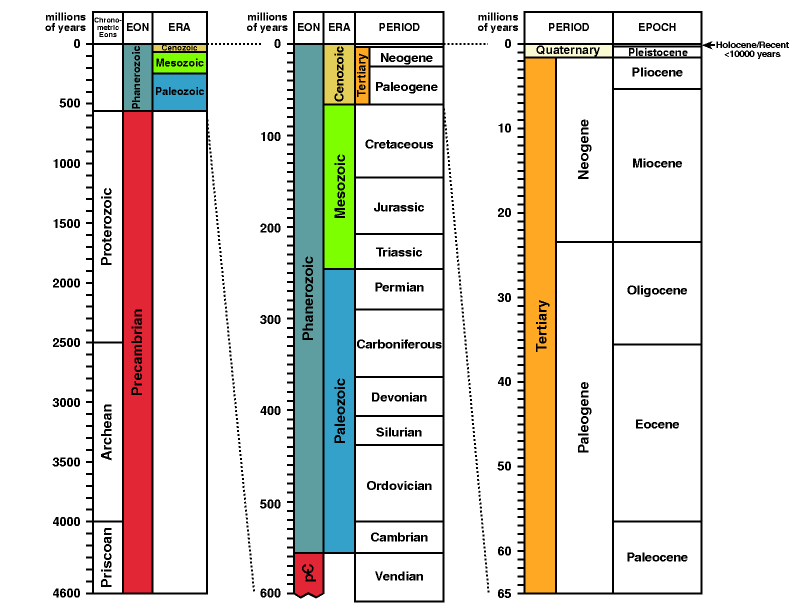|
|
Geological
Timescale |
| Timescale |
Geological
Timescale |
The Geological Timescale
 |
The Geological Time Scale, spanning several orders of magnitude of deep time. Time is read from the bottom (oldest) up. At the left are eons, lasting for a billion years or more, then eras and periods (central column), charting the evolution of complex life during the Phanerozoic, and finally epochs, on the right, measured "only" in millions of years. The recent (Holocene) epoch (upper right) lasts a mere ten thousand years, a blink of an eye geologically speaking. The version of the geological timescale presented here has since been revised by Gradstein et al 2004.
|
Few discussions in geology can occur without reference to geologic time. Geologic time is often discussed in two forms:
- Relative time ("chronostratic") -- subdivisions of the Earth's geology in a specific order based upon relative age relationships (most commonly, vertical/stratigraphic position). These subdivisions are given names, most of which can be recognized globally, usually on the basis of fossils.
- Absolute time ("chronometric") -- numerical ages in "millions of years" or some other measurement. These are most commonly obtained via radiometric dating methods performed on appropriate rock types.
Think of relative time as physical subdivisions of the rock found in the Earth's stratigraphy, and absolute time as the measurements taken upon those to determine the actual time which has expired. Absolute time measurements can be used to calibrate the relative time scale, producing an integrated geologic or "geochronologic" time scale.
It is important to realize that with new information about subdivision or correlation of relative time, or new measurements of absolute time, the dates applied to the time scale can and do change. Revisions to the relative time scale have occurred since the late 1700s. The numerically calibrated geologic time scale has been continuously refined since approximately the 1930s (e.g., Holmes, 1937), although the amount of change with each revision has become smaller over the decades (see fig. 1.5 and 1.6 of Harland et al.) and a few numerical estimates were available previously (but often for the duration of the entire scale rather than its individual subdivisions).
In addition, like any good scientific measurement, every dated boundary has an uncertainty associated with it, expressed as "± x millions of years". These can not be included in the diagram for practical reasons, but can be found in Harland et al., 1990, along with a detailed description of the history of earlier-proposed time scales and the terminology, methodology and data involved in constructing this geological time scale.
Because of continual refinement, none of the values depicted in this diagram should be considered definitive, even though some have not changed significantly in a long time and are very well constrained (e.g., the cretaceous/Tertiary boundary has been at 65±1 Ma for decades, and has been tested innumerable times, with almost all dates somewhere between 64 and 66 million years). The overall duration and relative length of these large geologic intervals is unlikely to change much, but the precise numbers may "wiggle" a bit as a result of new data.
This geological time scale is based upon Harland et al., 1990, but with the Precambrian/Cambrian boundary modified according to the most recently-published radiometric dates on that interval, revising the boundary from 570±15 million years to 543±1 million years ago Grotzinger et al., 1995). Other changes have been proposed since 1990 (e.g., revision of the Cretaceous by Obradovich, 1993), but are not incorporated because they are relatively small.
The time scale is depicted in its traditional form with oldest at the bottom and youngest at the top -- the present day is at the zero mark. Geologic time is finely subdivided through most of the Phanerozoic (see Harland et al., 1990 for details), but most of the finer subdivisions (e.g., epochs) are commonly referred to by non-specialists only in the Tertiary. Because of the vast difference in scale, the younger intervals have been successively expanded to the right to show some of these finer subdivisions.
References
Blatt, H.; Berry, W.B.N.; and Brande, S., 1991. Principles of Stratigraphic Analysis. Blackwell Scientific Publications: Boston, p.1-512. ISBN 0-86542-069-6 [Chapter 4 provides an introduction to geologic time. This is a good starting point to get the basic principles.]
Felix M. Gradstein, James G. Ogg, Alan G. Smith (Editors); A Geologic Time Scale 2004, Cambridge University Press, 2005, (ISBN 0-521-78673-8) [The standard reference on the geological timescale, at least until a further revision comes along! MAK110830]
Grotzinger, J.P.; Bowring, S.A.; Saylor, B.Z.; and Kaufman, A.J., 1995 Oct.27). Biostratigraphic and geochronologic constraints on early animal evolution. Science, v.270, p.598-604. [The most recent revision of the age of the Precambrian/Cambrian boundary.]
Harland, W.B.; Armstrong, R.L.; Cox, A.V.; Craig, L.E.; Smith, A.G.; and Smith, D.G., 1990. A geologic time scale, 1989 edition. Cambridge University Press: Cambridge, p.1-263. ISBN 0-521-38765-5 [One of the more recent compilations of the entire geologic time scale.]
Holmes, A., 1937. The Age of the Earth (new edition, revised). Nelson:London, p.1-263. [One of the earlier attempts at an integrated geochronologic time scale.]
Obradovich, J.D., 1993. A Cretaceous time scale. IN: Caldwell, W.G.E. and Kauffman, E.G. (eds.), Evolution of the Western Interior Basin.
Geological Association of Canada, Special Paper 39, p.379-396. [Proposes revisions to the Cretaceous time scale at the resolution of stages (finer divisions than shown on diagram above) and sub-stages.]
© 1996 Andrew MacRae, email: macrae@geo.ucalgary.ca, edited RFVS111109
This file may be freely used for non-commercial purposes provided its original source is indicated. Please contact the author for other arrangements.
